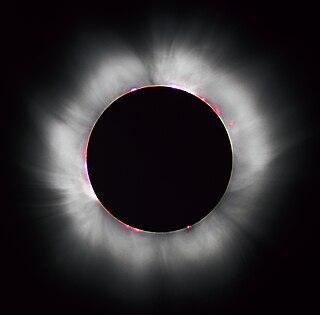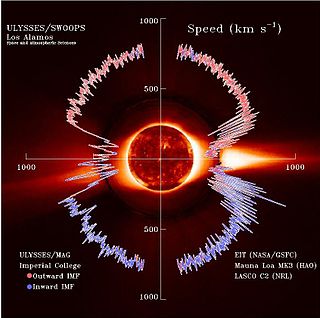Related Research Articles

A corona is the outermost layer of a star's atmosphere. It consists of plasma.

The solar wind is a stream of charged particles released from the upper atmosphere of the Sun, called the corona. This plasma mostly consists of electrons, protons and alpha particles with kinetic energy between 0.5 and 10 keV. The composition of the solar wind plasma also includes a mixture of materials found in the solar plasma: trace amounts of heavy ions and atomic nuclei of elements such as C, N, O, Ne, Mg, Si, S, and Fe. There are also rarer traces of some other nuclei and isotopes such as P, Ti, Cr, 54Fe and 56Fe, and 58Ni, 60Ni, and 62Ni. Superimposed with the solar-wind plasma is the interplanetary magnetic field. The solar wind varies in density, temperature and speed over time and over solar latitude and longitude. Its particles can escape the Sun's gravity because of their high energy resulting from the high temperature of the corona, which in turn is a result of the coronal magnetic field. The boundary separating the corona from the solar wind is called the Alfvén surface.

Eugene Newman Parker was an American solar and plasma physicist. In the 1950s he proposed the existence of the solar wind and that the magnetic field in the outer Solar System would be in the shape of a Parker spiral, predictions that were later confirmed by spacecraft measurements. In 1987, Parker proposed the existence of nanoflares, a leading candidate to explain the coronal heating problem.

The Solar Orbiter (SO) is a Sun-observing probe developed by the European Space Agency (ESA) with a National Aeronautics and Space Administration (NASA) contribution. Solar Orbiter, designed to obtain detailed measurements of the inner heliosphere and the nascent solar wind, will also perform close observations of the polar regions of the Sun which is difficult to do from Earth. These observations are important in investigating how the Sun creates and controls its heliosphere.
Solar physics is the branch of astrophysics that specializes in the study of the Sun. It deals with detailed measurements that are possible only for our closest star. It intersects with many disciplines of pure physics, astrophysics, and computer science, including fluid dynamics, plasma physics including magnetohydrodynamics, seismology, particle physics, atomic physics, nuclear physics, stellar evolution, space physics, spectroscopy, radiative transfer, applied optics, signal processing, computer vision, computational physics, stellar physics and solar astronomy.

The Solar Dynamics Observatory (SDO) is a NASA mission which has been observing the Sun since 2010. Launched on 11 February 2010, the observatory is part of the Living With a Star (LWS) program.

Heliophysics is the physics of the Sun and its connection with the Solar System. NASA defines heliophysics as "(1) the comprehensive new term for the science of the Sun - Solar System Connection, (2) the exploration, discovery, and understanding of Earth's space environment, and (3) the system science that unites all of the linked phenomena in the region of the cosmos influenced by a star like our Sun."

In solar physics, a coronal loop is a well-defined arch-like structure in the Sun's atmosphere made up of relatively dense plasma confined and isolated from the surrounding medium by magnetic flux tubes. Coronal loops begin and end at two footpoints on the photosphere and project into the transition region and lower corona. They typically form and dissipate over periods of seconds to days and may span anywhere from 1 to 1,000 megametres in length.

The Parker Solar Probe is a NASA space probe launched in 2018 with the mission of making observations of the outer corona of the Sun. It will approach to within 9.86 solar radii from the center of the Sun, and by 2025 will travel, at closest approach, as fast as 690,000 km/h (430,000 mph), or 0.064% the speed of light. It is the fastest object ever built by humans.
The Arctowski Medal is awarded by the U.S. National Academy of Sciences "for studies in solar physics and solar-terrestrial relationships." Named in honor of Henryk Arctowski, it was first awarded in 1969.

The Heliophysics Science Division of the Goddard Space Flight Center (NASA) conducts research on the Sun, its extended Solar System environment, and interactions of Earth, other planets, small bodies, and interstellar gas with the heliosphere. Division research also encompasses geospace—Earth's uppermost atmosphere, the ionosphere, and the magnetosphere—and the changing environmental conditions throughout the coupled heliosphere.

Craig Edward DeForest is an American solar physicist and the Vice-Chair of the American Astronomical Society's Solar Physics Division. He leads the heliophysics research group at the Boulder, Colorado offices of the Southwest Research Institute and holds an adjunct faculty position at the University of Colorado, Boulder. His wide-ranging contributions to the field of experimental astrophysics of the Sun include: early work on the MSSTA, a sounding rocket that prototyped modern normal-incidence EUV optics such as are used on the Solar Dynamics Observatory; his discovery of sound waves in the solar corona in 1998; standardization of computer vision techniques that are used to measure and track magnetic fields on the solar surface; co-invention with colleague Charles Kankelborg of the fluxon semi-Lagrangian approach to numerical MHD modeling; and pioneering work on quantitative remote sensing of the solar wind via Thomson scattered light.
Katharine Reeves is an astronomer and solar physicist who works at the Center for Astrophysics | Harvard & Smithsonian (CfA).. She is known for her work on high temperature plasmas in the solar corona, and measurement/analysis techniques to probe the physics of magnetic reconnection and thermal energy transport during solar flares; these are aspects of the coronal heating problem that organizes a large part of the field. She has a strong scientific role in multiple NASA and international space missions to observe the Sun: Hinode ; IRIS ; SDO; Parker Solar Probe; and suborbital sounding rockets including the MaGIXS and Hi-C FLARE high-resolution spectral imaging packages.

Eckart Marsch is a German theoretical physicist, who worked from 1980 to 2012 at the originally named Max Planck Institute for Aeronomy, from 2004 on named Max Planck Institute for Solar System Research (MPS) in Katlenburg-Lindau on the physics of the solar wind, solar corona and space plasmas and taught at the University of Göttingen.

Lindsay Erin Glesener is a professor in the Institute for Astrophysics at the University of Minnesota. She is a National Science Foundation CAREER Award researcher and lead investigator on the FOXSI Sounding Rocket.
Polarimeter to Unify the Corona and Heliosphere (PUNCH) is a future mission by NASA to study the unexplored region from the middle of the solar corona out to 1 AU from the Sun. PUNCH will consist of a constellation of four microsatellites that through continuous 3D deep-field imaging, will observe the corona and heliosphere as elements of a single, connected system. The four microsatellites were initially scheduled to be launched in October 2023, but they have since been moved to an April 2025 launch in rideshare with SPHEREx.
Judith Tobi Karpen is an American astrophysicist who works for NASA as chief of the Space Weather Laboratory at the Goddard Space Flight Center. She is known for her research on solar prominences and the solar wind, including the use of the Solar Dynamics Observatory to observe the fine structure of plumes in the solar corona.
Kelly Korreck is an American space scientist. She is currently an astrophysicist at the Center for Astrophysics | Harvard & Smithsonian and Program Scientist at NASA as head of operations for the Solar Wind Electrons Alphas and Protons (SWEAP) instrument aboard the Parker Solar Probe spacecraft.
Cristina Hemilse Mandrini is an Argentinian solar physicist. She is currently a researcher at the Argentinian National Council for Scientific and Technical Research (CONICET) and a professor at the University of Buenos Aires.

The Alfvén surface is the boundary separating a star's corona from the stellar wind defined as where the coronal plasma's Alfvén speed and the large-scale stellar wind speed are equal. It is named after Hannes Alfvén, and is also called Alfvén critical surface, Alfvén point, or Alfvén radius. Parker Solar Probe became the first spacecraft that crossed Alfvén surface of the Sun.
References
- ↑ Viall, N.M., Spence, H.E., Vourlidas, A., and Howard, R., "Examining Periodic Solar-Wind Density Structures Observed in the SECCHI Helisopheric Imagers", 2010, Solar Physics 261, 175.
- ↑ Viall, N.M., and Borovsky, J.E., "Nine Outstanding Questions of Solar Wind Physics", 2020, J. Geophys. Res. Grand Challenges in the Earth and Space Sciences, 125.
- ↑ Viall, N.M., DeForest, C.E., and Kepko, L., "Mesoscale Structure in the Solar Wind", 2021, Frontiers in Astronomy and Solar System Physics 8, 139.
- ↑ "Cambridge: About the Eddington Lecture" . Retrieved 13 March 2023.
- ↑ "RAS: RAS Ordinary Meeting schedule, March 2023" . Retrieved 13 March 2023.
- ↑ "AAS/SPD: Harvey Prize Previous Winners" . Retrieved 13 March 2023.
- ↑ "NASA/GSFC Solar Physics Laboratory: Awards Won" . Retrieved 13 March 2023.